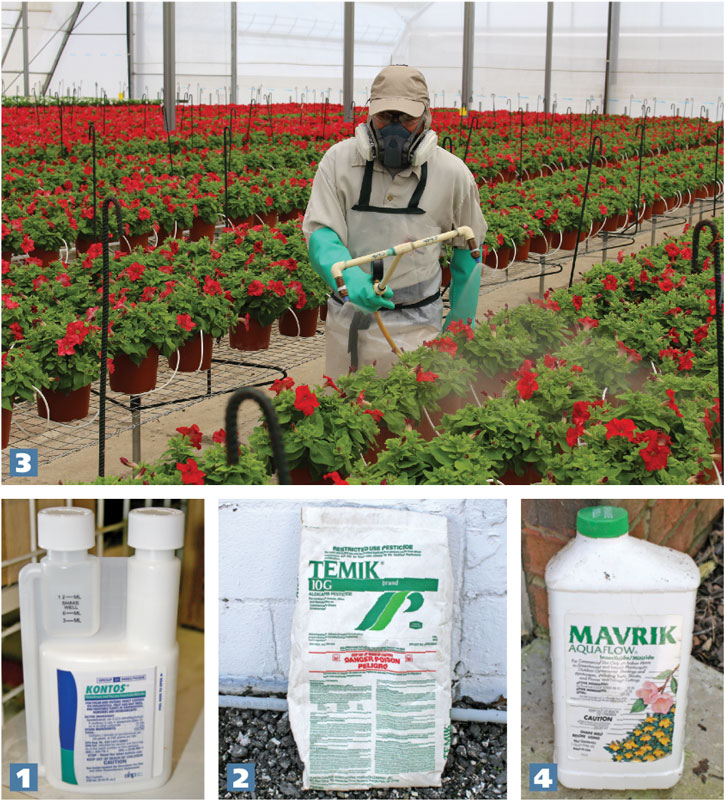2/1/2021
Change It Up
Dr. Raymond A. Cloyd

Insecticides are still the primary means of managing insect pests, including aphids, fungus gnats, leafminers, mealybugs, shore flies, thrips and whiteflies in greenhouse production systems. Insecticides are classified into two categories: broad-spectrum and narrow-spectrum. Broad-spectrum insecticides are registered for and have activity on a multitude of insect pests (Figure 1), whereas narrow-spectrum insecticides typically target less than three insect pests.
Broad-spectrum insecticides can have specific-site or multiple-site modes of action. Specific-site mode of action broad-spectrum insecticides are active on discrete target sites in the central nervous system or enzymes affiliated with metabolism. Consequently, those broad-spectrum insecticides with specific-site modes of action are more susceptible to insect pests developing resistance. However, multiple-site mode of action broad-spectrum insecticides have activity on a variety of target sites or possess multiple modes of action, which reduces susceptibility to insect pest populations developing resistance.
Figure 1. Spirotetramat (Kontos) is an example of a broad-spectrum insecticide.
Figure 2. Temik (aldicarb) was a broad-spectrum insecticide with long-residual activity.
Figure 3. Applying insecticides with the same mode of action will enhance the development of insecticide resistance.
Figure 4. Do not exclusively use broad-spectrum insecticides with specific-site modes of action.
Previously, greenhouse producers had a number of insecticides that were broad-spectrum in activity, killing nearly all insect pests encountered during crop production and had very long-residual activity (persistence), including aldicarb (Temik; Figure 2), oxamyl (Vydate), methomyl (Lannate) and bendicarb (Dycarb/Ficam). Broad-spectrum insecticides currently available are in the chemical classes organophosphate (acephate and chlorpyrifos), carbamate (mesurol), pyrethroid (bifenthrin, cyfluthrin, fenpropathrin and pyrethrins), and neonicotinoid (acetamiprid, dinotefuran, imidacloprid and thiamethoxam). These broad-spectrum insecticides have specific-site modes of action. Broad-spectrum insecticides with multiple-site modes of action include insecticidal soap (potassium salts of fatty acids), horticultural oils (petroleum, mineral or neem-based) and entomopathogenic fungi (Beauveria bassiana [BotaniGard] and Isaria fumosorosea [Ancora]).
Insecticide rotation is the temporal (time) alternation of insecticides with different modes of action. Repeatedly using the same mode of action results in increased selection pressure on an insect pest population, which enhances the rate (speed) of resistance development (Figure 3). Therefore, it’s important to rotate broad-spectrum insecticides with different modes of action to reduce the potential for resistance developing in insect pest populations. This will result in reduced selection pressure on insect pest populations, thus decreasing the rate of resistance development. The reduction in selection pressure using broad-spectrum insecticides with different modes of action will increase their longevity and preserve their
effectiveness.
An appropriate rotation scheme involves using one broad-spectrum insecticide for the duration of one generation of an insect pest population (about two to three weeks), then rotate or switch to another broad-spectrum insecticide with a completely different mode of action. Avoid rotating broad-spectrum insecticides with different modes of action within a single insect generation. In addition, do not use broad-spectrum insecticides with specific-site modes of action exclusively (Figure 4) because broad-spectrum insecticides with specific-site modes of action target a single mechanism or biological pathway in the central nervous system of insect pests, which can enhance the development of insecticide resistance.
In conclusion, greenhouse producers need to use broad-spectrum insecticides judiciously and make sure to rotate different modes of action throughout the growing season to reduce the potential for resistance developing in insect pest populations. GT
Raymond A. Cloyd is Professor and Extension Specialist in Horticultural Entomology/Plant Protection at Kansas State University in Manhattan, Kansas. He can be reached at rcloyd@ksu.edu or (785) 532-4750.